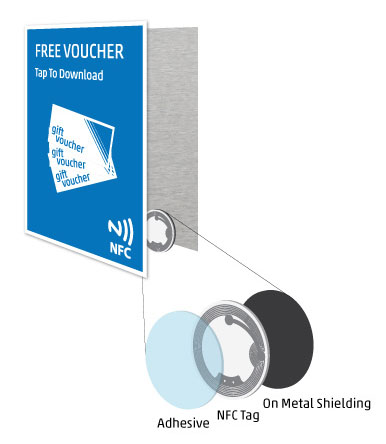Seritag stock a range of on-metal NFC tags including labels and industrial tags. However, we also stock a slightly different type of on-metal label called a 'reverse on-metal tag'. This article describes the difference and why and when you should use the reverse variant instead of a normal tag.
NFC Tags work by electromagnetic induction. This is where a magnetic field is generated by the reader creating (inducing) energy in the coil of the NFC tag. Any metal behind the tag interferes with this field and prevents the tag from 'powering up'. To be clear, NFC Tags can never work behind metal. However, if you want to place the tag on metal you either need to have a small gap between the tag and the surface or use a special 'on-metal' tag.
To make an on-metal NFC tag work, we add an additional 'barrier' or 'ferrite' layer between the NFC antenna and the metal surface. This additional barrier prevents (or reduces the effect) of the metal from interfering with the function of the tag.
A normal on-metal NFC tag is designed to be attached to metal with the phone scanning from the non-adhesive side. The barrier layer is between the antenna and the adhesive so that the barrier is stuck to the metal.
A reverse on-metal tag has the adhesive on the other side of the antenna to the barrier. This is so that the tag can be attached to something that is then stuck to the metal resulting in the ferrite barrier being against the metal and the antenna facing the user.
The reason NFC Tags don't work on metal is that the metal surface behind the tag acts as a ground plane and reduces the performance of the tag's antenna, effectively stopping it creating the current needed to power the chip.
To allow the tags to work on metal surfaces, you can create a small gap between the tag and metal about 0.5-1 cm, however if you do not have the space to create this gap you can use an on-metal tag, which has a barrier layer that only measures a fraction of a millimetre thick.
Normal on-metal tags have a ferrite foil barrier layer between the tag and adhesive layer as such:

The ferrite foil creates a 'barrier' to the metal surface so that the antenna and chip can function properly.
The new ‘Reverse’ on-metal tags, are just like the normal on-metal tags, however the ferrite layer is the top layer of the tag, like so:

This design is perfect for when you would rather have the tag hidden, or behind something like a poster, but still require the on-metal features of the tag. These reverse on-metal tags are designed to be stuck to the back of an object (label, poster, table marker, etc) which is then placed onto the metal item, like so:

On-metal NFC tag have a scan distance (how close the phone needs to be to read the tags) noticeably and significantly less than standard NFC tags. This is partly due to the ferrite layer aborbing energy, but also due to tuning, energy leakage into the metal and so on.
It is also worth noting that there will be a reduction in performance of on-metal tags even when they are not placed on metal. It's not unusual for the scan distance to be half that of a comparable 'normal' tag placed on a non-metal surface. As an example, a recent Seritag project measuring the scan distance of our tags, the 19x19mm white on-metal label has a scan distance of 21mm-25mm, however on metal the tag scan distance is noticeably less; 6mm-10mm. As a comparison, the normal 19mmx19mm square tag has a scan distance of 26mm-30mm.
Seritag typically use very high-quality ferrite material made to strict RoHS and performance standards. As a result, the performance when the tags are not on-metal and when they are is usually very similar. However, some tags are better than others.
Seritag currently stock the 29mm round Reverse on-metal tag which is a high-quality product with the ferrite barrier layer on the top. These tags contain the popular NTAG213 and can work on both metal and non-metal surfaces, and for this type of product, amazing scan distances on both metal and non-metal surfaces. Supplied on reels in larger quantities or strips of 5 in smaller orders. These tags are available with our Seritag encoding or UID scan services.




